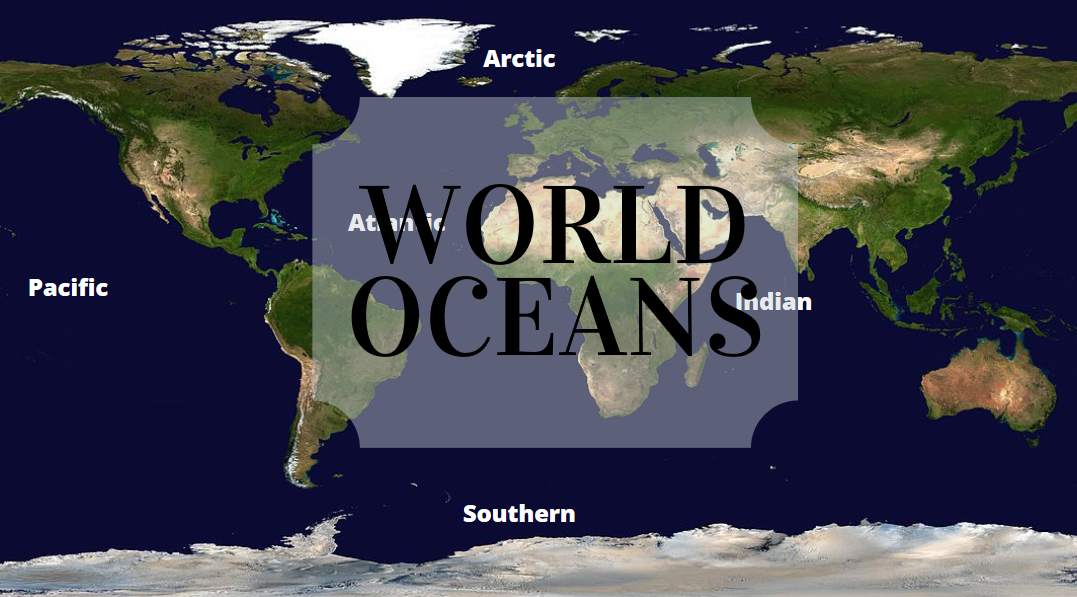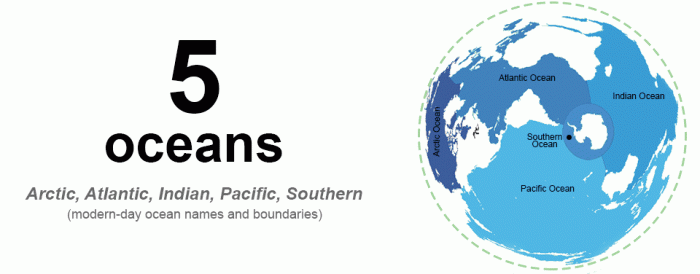
Historically there were 4 named oceans in the world, which include the Atlantic Ocean, Pacific Ocean, Arctic Ocean, and the Indian Ocean. However, today we recognize 5 oceans in the world, with the Southern Ocean added to the list.
The ocean is one of Earth’s most mysterious places and is crucial to our way of life. It supplies us with food and many other resources. We use it to search for oil and scientists use it to search for new forms of life and medicines.
The ocean comprises over 139,434,000 sq mi and has a total volume of 320,000,000 cubic miles. This represents about 71% of the Earth’s surface. We have only explored about 5%of the ocean so far while the remaining 95% have not been seen by humans. There are a lot of places we have not seen and a lot of species that have yet to be discovered.
As we continue to explore and learn about the ocean, it becomes important to understand how it is defined by the world and what features it has that are crucial to the stability of the world. It is also important to understand how humans have affected the health and welfare of the ocean. Ours is not the only ocean in the solar system and the more we understand our own, the better we will be able to approach studying those foreign places.
How many oceans are there? There are 5 oceans:
- The Atlantic Ocean
- The Pacific Ocean
- The Arctic Ocean
- The Indian Ocean
- The Southern Ocean
How Many Oceans Do We Have?
Historically, there are four oceans: Atlantic, Pacific, Arctic, and Indian. These oceans are recognized by almost all oceanic organizations around the world. It is the standard classification that is held by National Geographic. Technically, there is only a single ocean: the world ocean. This is because the ocean is comprised of one global and interconnected body of saltwater. We break that single ocean into parts because the parts contain specific features and characteristics that are definitive to those regions.
| Earth’s Oceans | Interesting Facts |
| Area | 140 million square miles (71% of the Earth’s surface) |
| Average Depth | 12,200 feet (3,720 m) |
| Deepest point | 36,198 feet (11,033 m); the deepest point is the Mariana Trench in the western Pacific |
| Highest Mountain | Mauna Kea in Hawaii rises 33,474 feet (10,203 m) from its base on the ocean floor |
| Marine Species | 226408 (discovered) |
| Mountains | Massive mountain ranges that are 40,000 miles (64,000 km) long |
The different parts of the world’s oceans are defined by the continents, archipelago, and other features in the surrounding area. These defined areas are further broken down into smaller areas. The Atlantic Ocean resides between the Americas, Europe, and Africa. It is further broken down into the North Atlantic Ocean and the South Atlantic Ocean by the equator. Parts of these oceans are defined as gulfs, seas, straits, and other bodies of water within the oceans.
Recently in 2000, the International Hydrographic Organization (IHO) defined a new 5th ocean: The Southern Ocean. This ocean extends from the shores of Antarctica to the line of latitude at 60 degrees South. This new ocean is recognized by the U.S. Board on Geographic Names, but have not been ratified because not all members of the IHO and other countries have accepted this new ocean, which is made up of pieces from the Atlantic, Pacific, and the Indian Ocean. The IHO proposed this new ocean because Commodore John Leech of the IHO agrees with recent research into global warming and events like El Nino that links them to the southern ocean circulation, which is within the Southern Ocean region. The unique ecology and features of this region are sufficient enough, by IHO standards, to give it its own classification.
Number Of Oceans In The World (Historically Standard): 4
- Atlantic Ocean
- Pacific Ocean
- Arctic Ocean
- Indian Ocean
Number Of Oceans In The World (New IHO Standard): 5
- Atlantic Ocean
- Pacific Ocean
- Arctic Ocean
- Indian Ocean
- Southern Ocean

Image from NOAA
Features Of The Ocean(s)
“We are tied to the ocean. And when we go back to the sea, whether it is to sail or to watch, we are going back from whence we came.” — John F. Kennedy
Pacific Ocean
The Pacific ocean is probably best known for having the ring of fire as its big feature. The Pacific is the largest and oldest of the oceans. Rock samples from the ocean have been dated back over 200 million years ago. This region is also the home of the ring of fire, which is characterized by immense earthquakes and volcanic activity. This is because tectonic plates below the ocean are colliding with the continental plates along the ridges of the Pacific ocean. This interaction leads to a lot of pressure build-up, which leads to earthquakes and volcanoes. The Pacific Ocean is also home to the Mariana Trench, which is the deepest part of the ocean. Unfortunately, the Pacific ocean is home to the largest gathering of plastics that humans have released into the environments. These plastics affect the ecosystems of numerous species and even make their way back to humans, inside of fishes.
Atlantic Ocean
The Atlantic ocean is the second largest of the oceans and it is the saltiest of the oceans. The saltiness comes from evaporation, precipitation, and water flows from numerous rivers belonging to the four continents it is surrounded by. The Atlantic ocean is home to the largest island in the world, Greenland, and is also home to the Bermuda Triangle, infamous for its ability to drown ships and planes that cross over it. The Atlantic is also the most active ocean for travel because of its connection to four different continents.
Indian Ocean
The Indian Ocean is the third largest ocean and is home to many climate variabilities. The climate variability is due to monsoon wind systems that divide the ocean and causes conflicting weather and temperatures in those regions. Overall, the Indian ocean is the warmest of the oceans and this results in it having a limited marine life. Despite this, it is home to breeding humpback whales and the second largest population of tuna.
Arctic Ocean
The Arctic Ocean is the smallest of the oceans and also the shallowest. One of the most different features from all the other oceans is that the arctic ocean is covered in mountains of ice throughout most of the year. Despite the ice and cold, humans have managed to live there and even explore. The Arctic is home to the geographic north pole, which has been sought after by many explorers. The Arctic is also home to many fish and animals, including polar bears. It is estimated that by 2040, the majority of the ice (if not all) will be melted because of global warming. This results in the release of natural gases, organisms, and nutrients that were all trapped in the ice. The melting would also result in the death of numerous species, including polar bears because they would lose their habitats.
As we continue to explore and understand the ocean, hopefully, we will be able to protect it from the effects of humans. We may one day be able to clean up the messes we have caused from plastics to oil spills. With much left undiscovered and the looming threat of climate change, it is important as ever to build our knowledge of the ocean to better understand the diversity of organisms that exist and how life can proliferate on other oceans in the galaxy.









